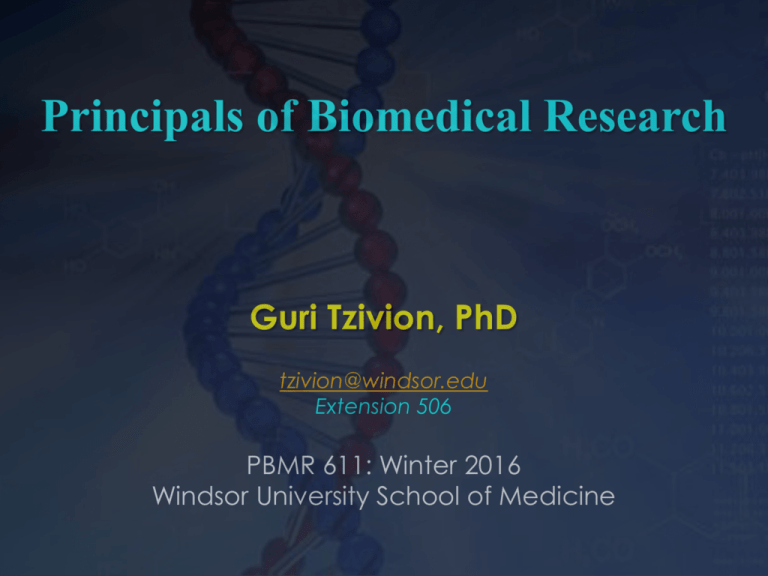PBMR 611 Class 3
advertisement

Principals of Biomedical Research Guri Tzivion, PhD tzivion@windsor.edu Extension 506 PBMR 611: Winter 2016 Windsor University School of Medicine Journal Club Instructors Dr. Soumitra Chakravarty Biochemistry Group 1 Dr. Samuel Taiwo Pre Med Program Group 4 Dr. Vivek Joshi Biochemistry Group 2 Dr. Fatai Oluyadi Pathophysiology Group 5 Dr. Bikramajit Singh Saroya Pathophysiology Group 3 Dr. Kusai Salhanie Pathophysiology Group 6 PBMR 611 MDII: Principals of Biomedical Research Class 3 Introduction to Biomedical Research 3. Research formats: original research versus topical/systemic literature review Research formats: 1. Original research 2. Topical/systemic literature review Original research: Covers many disciplines such as: 1. Basic research 2. Applied research 3. Pre-clinical research 4. Clinical research: Clinical trials Epidemiological research Disparities research Basic Research Research conducted to increase fundamental knowledge & understanding of physical, chemical, and functional mechanisms of life processes and diseases It poses specific challenges since it is not necessarily directed toward solving any particular problem Provides the building blocks for the other types of research Examples of basic research in the study of AIDS Scientist asks basic questions regarding T-cell function, for example, the function of CD4 molecules. Mechanisms for Virus-host interactions Mechanisms of virus replication MHC molecule variability and susceptibility to infection Examples of basic research in the study of cancer Mechanisms of growth factor signaling DNA repair mechanisms Cell cycle regulation Immune surveillance and recognition of self antigens Viral transmitted genes Examples of basic research in the study of metabolic disorders Mechanisms of insulin action Autoimmune disorders Intracellular signaling processes Inflammation and stress-activated pathways Aging processes in invertebrates Environmental and genetic factors affecting longevity in the C.elegans model DAF-16 Baumeister, J Endocrinol. 2006 Regulation of Sir2 during calorie restriction in yeast Resveratrol Bordone and Guarente Nat Rev Mol Cell Biol 2005 The diverse physiological roles of the sirtuins Finkel et al. Nature 460, 2009 Applied Research Directed toward specific objectives, for example, development of new drugs, treatment modalities, or surgical procedures Can be conducted with animals or non- animal models (computer modeling or tissue cultures) or using human subjects (clinical trials) Preclinical Research Used to test specific hypotheses or experimental treatment modalities on animal or other study models before moving the treatment to clinical trials in humans. Clinical Research Used when other forms of research have taken place Used to test potential drugs and treatments in humans Builds on what is done in basic and applied stages Clinical Research Involves also research aimed at identifying specific disease factors or susceptibility in different populations, racial differences etc. Topical/systemic literature review: Covers all the various disciplines we discussed in basic research, but uses hypothesis-driven literature search as the main tool for conducting the research. Topical/systemic literature review aims to: 1. Provide knowledge and new perspective to help in better understanding the topic. 2. Provide a concise summary of the published material related to a specific research filed (educational objective) Systemic literature review research flow chart: 1. Select a research topic and conduct an initial literature review to get familiar with the topic 2. Develop a hypothesis you want to test 3. Conduct an unbiased literature search using keywords that address the hypothesis 4. Generate a library of relevant papers identified in the search Systemic literature review research flow chart: 5. Critically review the relevant literature, focusing on your initial hypothesis 6. Provide a concise summary of the literature, addressing your working hypothesis 7. Critically discuss your findings: do they support your hypothesis or negate it? 8. Make sure to properly cite the literature throughout your text and provide a reference list











